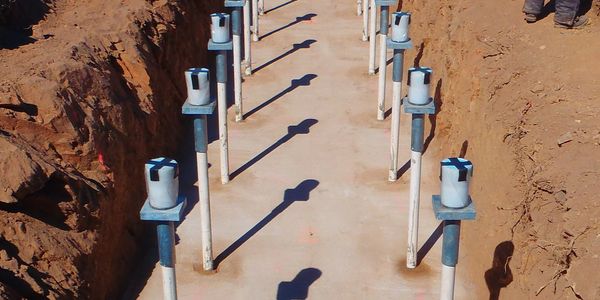Reliable Rock Anchors for Secure and Secure Structures
In the realm of civil design, the role of trusted rock supports can not be overemphasized, as they are critical in developing safe and secure and stable structures across a selection of applications. Understanding the various kinds of rock supports, their details applications, and the complexities of installation and upkeep is vital for optimizing their efficiency.
Kinds Of Rock Anchors

Passive anchors count on the weight of the framework and the surrounding soil or rock to give resistance. Active supports, on the various other hand, involve the application of stress via a high-strength wire or pole, developing a pre-stressed problem in the anchor - Williams Anchors.
Grouted anchors are another substantial classification, where a steel bar or cable is placed into a pierced hole, complied with by a cementitious grout. Once cured, the grout bonds with the surrounding rock, producing a robust anchoring system. Each type of rock anchor offers distinct advantages based upon the details geological problems and architectural demands, thereby playing a critical function in the general stability and longevity of constructed centers.
Applications in Building
Rock supports play a pivotal role in numerous construction applications, giving crucial support and security in varied environments. These ingenious services are used in jobs ranging from large-scale framework developments to smaller household structures. One of the main applications of rock anchors is in the stablizing of slopes and keeping wall surfaces, where they help stop soil erosion and maintain architectural stability.
Furthermore, rock supports contribute in safeguarding foundations for bridges, tunnels, and skyscrapers, guaranteeing they can stand up to side forces such as wind and seismic task. Their convenience enables installation in challenging geological conditions, making them perfect for tasks in mountainous or rocky terrains.

Key Choice Criteria
Selecting the appropriate rock support for a specific application needs mindful consideration of several crucial requirements. The geological problems of the website have to be completely assessed. Understanding rock kind, stamina, and security is vital to guarantee that the support will carry out efficiently under tons conditions.

An additional important aspect is the corrosion resistance of the anchor products. In atmospheres revealed to wetness or chemicals, making use of corrosion-resistant materials will certainly prolong the life-span of the anchors and preserve structural stability with time.
Additionally, the support's installation approach must straighten with the job's demands and restraints. Alleviate of setup, in addition to the possible effect on surrounding structures, have to be considered.
Installation Strategies
Efficient setup techniques are critical for the effective performance of rock supports. Correct setup makes sure that the supports attain the desired load-bearing capacity and stability within the geological problems. The primary step in the installment process entails site evaluation, where geological surveys determine the rock type, condition, and any type of potential obstacles.
When the site is reviewed, the proper exploration technique should be chosen-- alternatives consist of rotating boring, ruby boring, or percussion drilling. The option depends upon rock solidity and ecological considerations. Precise boring deepness and angle are necessary to guarantee that the anchors line official site up with structural requirements and load circulation.
After exploration, the next phase involves cleaning up the borehole to eliminate particles, which can jeopardize bond strength. Following this, the support is put, and if required, a cement or material is injected to boost adhesion. The healing time of these materials have to be adhered to, guaranteeing that the anchors attain full toughness before any kind of tons is used.
Upkeep and Assessment
Proper upkeep and assessment of rock anchors are necessary to guarantee their lasting efficiency and reliability (Williams Anchors). Regular analyses help recognize any type check it out of prospective concerns, such as rust, displacement, or architectural fatigue that could jeopardize the stability of the anchoring system
Routine examinations ought to be performed at defined periods, considering environmental variables and the details application of the rock anchors. Visual inspections should concentrate on the revealed sections of the supports, looking for indicators of rust, fractures, or various other abnormalities. In addition, it is important to evaluate the surrounding geological conditions to identify any changes in dirt or rock that may influence support efficiency.
Sometimes, advanced techniques such as tons testing or non-destructive screening may be warranted to determine the supports' load-bearing capability and general health. Proper documents of examination searchings for, upkeep activities, and any type of repairs or substitutes done is essential for recurring evaluation and compliance with market standards.
Final Thought
In conclusion, reputable rock anchors play an important role in guaranteeing protected and stable structures across various building applications. By effectively moving lots and improving security versus side forces, these supports add considerably to the durability and stability of frameworks such as bridges, tunnels, and preserving wall surfaces. Strategic choice, installment, and upkeep of rock supports are important for maximizing efficiency and guarding public safety, ultimately underscoring their value in contemporary design practices.